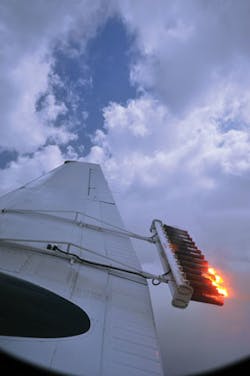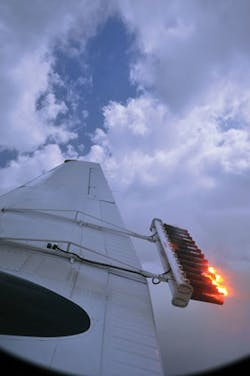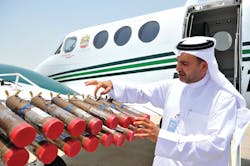Making it Rain: The Case for Cloud Seeding in the UAE
Facing diminishing aquifer levels, the United Arab Emirates is looking at rain enhancement as a means to supplement its existing freshwater supplies. Estimates suggest that by dispersing natural salts into clouds, the programme could increase rainfall by up to 35%.
By Alya Al Mazroui
Rapid population growth combined with diminishing fresh water supplies is posing an imminent threat to millions of people living in arid and semi-arid regions around the world.
The United Nations estimates that almost half of the world’s population will face high water stress by 2030. The implications for future demographic trends and migratory patterns are potentially enormous. For affected countries, water sustainability is becoming one of their most urgent economic and security challenges given projected demand.
In recent decades, many countries with limited fresh water and access to the sea have employed desalination plants to supplement their limited groundwater reserves.
The United Arab Emirates’ (UAE) rapid economic development over the past few decades has led to an exponential increase in the demand for fresh water, with the result that ancient underground aquifers currently providing two-thirds of domestic supply could face exhaustion in the future.
With demand at present estimated to be 353 litres per capita every day, the UAE has one of the highest rates of water consumption in the world. Additionally, current over-reliance on desalination methods in the UAE is compounded by a rise in overall national energy demand of approximately 9% every year.
Rain Enhancement
Unsustainable depletion rates of groundwater reserves and rising costs of desalination have led the UAE to turn to sustainable technologies to secure new sources of potable water. Masdar, the Abu Dhabi Government’s renewable energy company, is currently examining the feasibility of using reverse osmosis and forward osmosis technology for new, large-scale seawater desalination plants powered by renewable energy.
More ambitiously, the UAE authorities are also looking at rain enhancement as a means to supplement their existing freshwater supplies. More popularly known within the scientific and technical field as ‘cloud seeding’, rain enhancement offers as yet unrealised potential.
The UAE Research Program for Rain Enhancement Science, launched in January 2015, is an initiative of the UAE Ministry for Presidential Affairs, overseen by the National Centre for Meteorology and Seismology (NCMS), which offers a grant of US$5 million dollars over a three-year period to be shared by up to five winning research proposals.
The program’s core objective is the refinement of existing techniques to track and assess clouds, and the development of effective seeding capabilities to boost rainfall levels. The UAE original cloud-seeding program was initiated in the late 1990s, and was developed through cooperation between the NCMS and leading international organizations such as the National Center for Atmospheric Research in Colorado, USA, and the US Space Agency, NASA.
In 2005, the UAE launched the UAE Prize for Excellence in Advancing the Science and Practice of Weather Modification in collaboration with the World Meteorological Organization (WMO), which later evolved into the International Research Program for Rain Enhancement Science. The UAE now has more than 60 networked weather stations, an integrated radar network, and six specialised aircraft equipped for cloud seeding operations, which fly more than 150 missions each year.
Ongoing cloud seeding operations in the UAE target cloud formations that accumulate over the mountainous areas of the country, specifically during the hot season between April and October. During this period, humid air masses crossing the Arabian Sea can form as convective clouds when they meet the mountains in the eastern UAE.
In several previous cases, where these clouds were intensively targeted, encouraging results were seen. For example, in April 2013, intensified cloud seeding operations in the Al Quaa region of the Abu Dhabi Emirate coincided with a monthly rainfall level of 136mm, a significant amount given that the average April rainfall level for the area between 2003 and 2014 was calculated at 29.9mm.
It was possible that there was a correlation between the frequent seeding operations and increased rainfall levels. However, it was difficult to prove a link due to gaps in the seeding team’s understanding of cloud dynamics and lack of adequate tools for measuring precipitation levels.
The Seeding Process
When a suitable cloud is identified, the seeding materials are dispersed at the cloud base and dispersed within the cloud by updrafts. Once a seeding flare is ignited, up to 15 minutes are needed for the material to interact with the cloud molecules.
The process sees collision followed by coalescence: the materials are specifically designed to promote the clustering of droplets originally measuring 0.3-0.4 micrometres until they are heavy enough to fall as rain drops. In 2015 to date, the NCMS has conducted 110 cloud seeding flights and launched nearly 2,000 seeding flares.
Scientists working on these operations have estimated that targeted cloud seeding on suitable clouds can enhance rainfall by as much as 30-35% in a clean atmosphere, and by up to 10-15% in a turbid atmosphere. Staff at the NCMS stress that no harmful chemicals are used during these flights; instead, the seeding flares disperse natural salts such as potassium chloride and sodium chloride.
Despite these successes, significant technical and data-gathering obstacles remain. One of the key technical challenges faced is finding the means to accurately measure the extra precipitation generated.
Though NCMS scientists calculate that individual clouds can contain up to 1.02 cubic metres of water, they do not yet have the means to measure the extra rainfall generated within a margin of less than 5% either way. In addition, while some of the additional rain is collected by reservoirs in the more mountainous east of the UAE, some of this water is lost from run-off into the sea.
It is difficult to quantify the precise extent to which rain enhancement could add to the UAE’s existing reserves of fresh water. Yet it is hoped that refinements of existing technologies along with new innovations could increase water levels in existing catchment areas and provide a valuable supplement for use in the industrial and agricultural sectors.
Objectives
Although the immediate aim of UAE Research Program for Rain Enhancement Science is to build on the promising results achieved so far, the intention is to generate new insights and technologies that could have wider applications for countries suffering from scarcity of natural water resources.
A key aim of the program is forging international partnerships. The scientific community in China is one of the important potential collaborators identified by the Program. Through the use of weather modification to tackle air pollution and alleviated drought in affected agricultural regions, China has already demonstrated its scientific lead in weather modification.
Similarly, UAE cloud seeding specialists are also seeking to build productive partnerships with agricultural scientists and agro engineers in India who have used rain enhancement to boost rainfall levels in dry states such as Andhra Pradesh and Maharashtra. Through such innovation, rain enhancement has the potential to make an increasingly important contribution to water management strategies in arid and semi-arid regions.
Alya Al Mazroui is the program manager for the UAE Research Program for Rain Enhancement Science (UAEREP).
WWi Insight: Global Cloud Seeding Operations
Cloud seeding has been used elsewhere in the world over 60 years ago as a solution to drought. “Rainmaking” efforts started in Texas during a drought in the 1950s and continued into the 1960s.
Legislation was then adopted as a law in 1967, governing the use of weather modification technologies. In the late 1990s, a state-funded programme began. Initially, during periods of drought in Texas, as many as 51 million acres were included in cloud seeding “target” areas. More recently around 31 million acres are covered by the project. Pilots flying specially equipped aircrafts are directed to convective clouds believed by meteorologists to be treatable with the seeding agent. Seeding materials in the form of flares containing silver iodine and other compounds are placed into convective towers to induce them.
Meanwhile, the Rain Enhancement Division EMS Mekorot, subsidiary of Israeli water company Mekorot, is responsible for cloud seeding in the country between November and April. During the winters of 2012 and 2013, the company carried out cloud seeding sorties totaling 450 flight hours per season. The annual average is 330 flight hours per season. Merkorot claims that such activity leads to an increase in the amount of rainfall in Israel (in the north and above the drainage basin of the Sea of Galilee) of 10% -15% on average annually. These rates represent additional water of 30-40 million cubic meters per annum for the Sea of Galilee.
More Water & WasteWater International Archives Issue Articles


